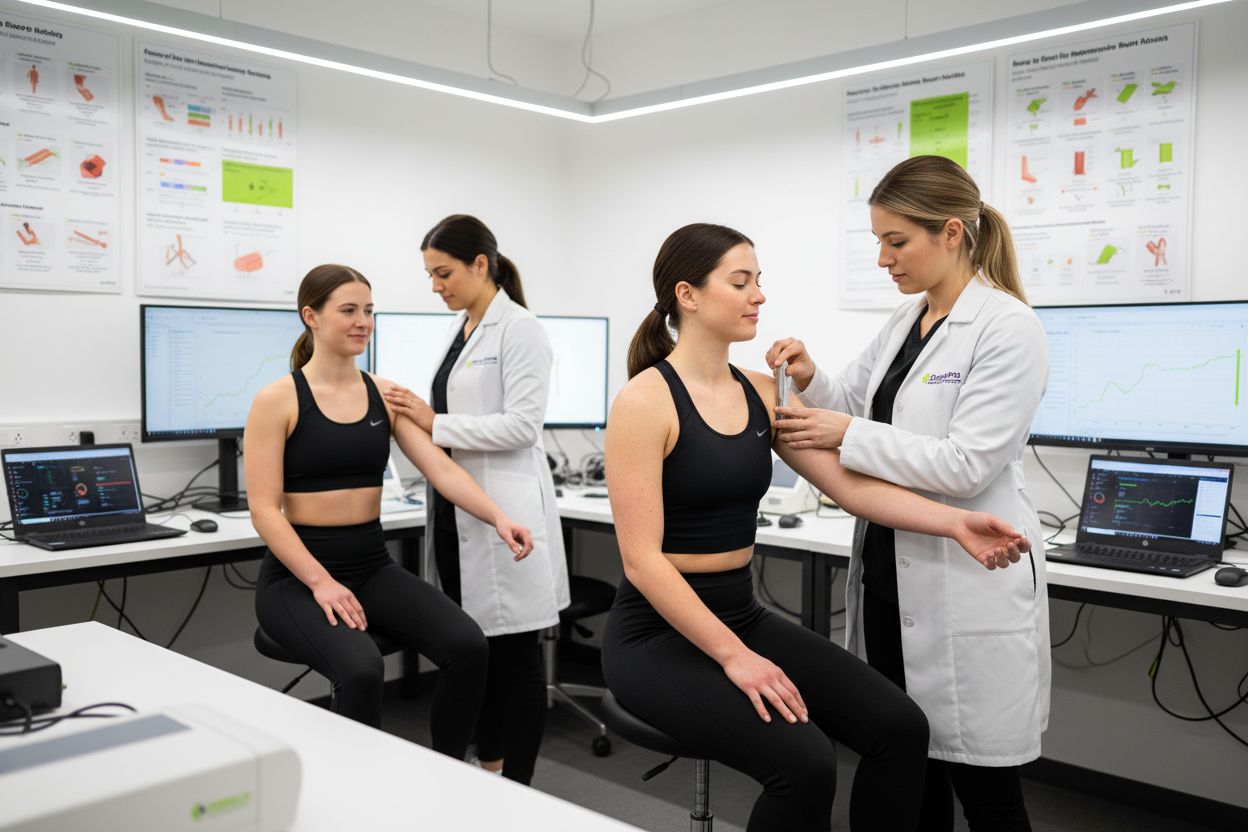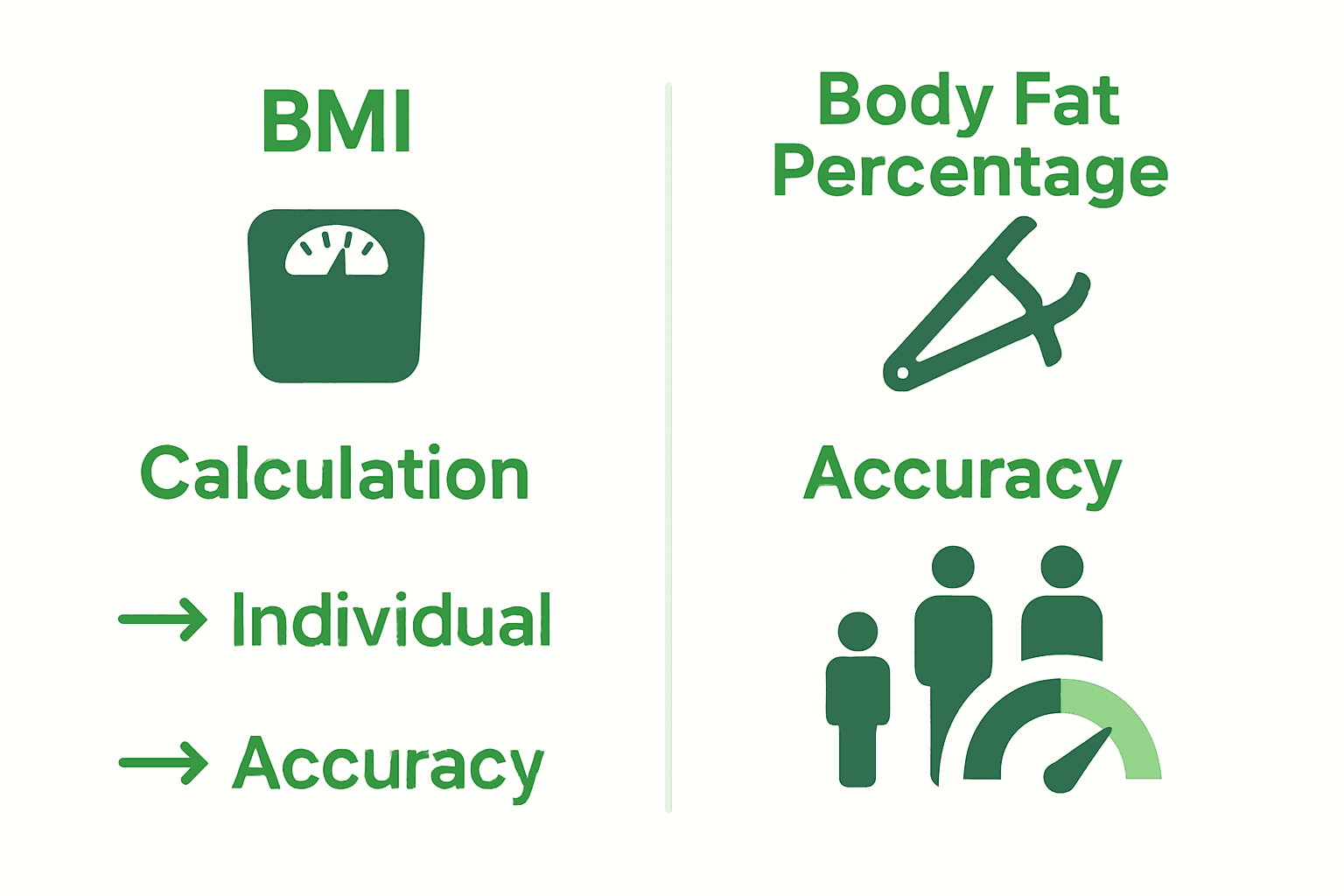Did you know over 30 percent of adults with a so-called normal BMI may still carry excess body fat that influences their long-term health? Understanding the numbers behind BMI and body fat percentage is more important than ever for anyone focused on wellness. By learning how these common health measurements differ and what they really tell you, you can make smarter choices about fitness, nutrition, and your overall well-being.
Key Takeaways
| Point | Details |
|---|---|
| BMI vs. Body Fat Percentage | BMI is a simple, quick tool for population-level insights, while body fat percentage offers more precise individual health indicators. |
| Limitations of BMI | BMI does not differentiate between muscle and fat, which may misclassify muscular individuals and obscure health risks. |
| Measurement Methods | Various body fat measurement techniques exist, each with different accuracy and accessibility, suggesting no single method is sufficient. |
| Health Risk Assessment | Body fat percentage has a stronger correlation with long-term mortality risk compared to BMI, emphasizing the need for comprehensive evaluations. |
Table of Contents
- Defining Bmi And Body Fat Percentage
- How Bmi Is Calculated And Used
- Understanding Body Fat: Measurement Methods
- Accuracy And Limitations Of Each Metric
- Comparing Health Risks And Practical Uses
Defining BMI and Body Fat Percentage
Understanding body composition metrics can feel like navigating a complex health maze, but two key measurements help decode your physical health: Body Mass Index (BMI) and body fat percentage. According to how to calculate body fat percentage, these metrics offer different yet complementary insights into your overall physical condition.
BMI, originally developed in the mid-19th century by Adolphe Quetelet, is a simple calculation using your weight and height. The formula divides your weight in kilograms by your height in meters squared, producing a numeric score that classifies individuals into weight categories:
- Underweight: Below 18.5
- Normal weight: 18.5 to 24.9
- Overweight: 25 to 29.9
- Obese: 30 and above
In contrast, body fat percentage directly measures the proportion of your total body mass composed of fat. This metric goes beyond simple weight calculations by providing a more nuanced view of body composition. Unlike BMI, body fat percentage accounts for essential fat needed for hormonal functions and storage fat, with typical ranges varying significantly between men and women. For more precise measurements, our body fat calculator can help you understand your exact body composition.
How BMI Is Calculated and Used
Calculating Body Mass Index (BMI) is straightforward, requiring just two basic measurements: your weight and height. According to the BMI Calculator, the formula is weight (kg) divided by height (meters) squared, which produces a single numeric score representing your weight category.
The World Health Organization uses specific BMI thresholds to classify adult weight status globally:
- Underweight: Below 18.5
- Normal weight: 18.5 to 24.9
- Overweight: 25 to 29.9
- Obese: 30 and above
Healthcare professionals widely use BMI for population-level health surveillance because it’s easy, inexpensive, and provides a quick snapshot of potential weight-related health risks. However, it’s not a perfect metric. The measurement can misclassify muscular individuals and doesn’t account for fat distribution or muscle-to-fat ratios. Athletes or people with high muscle mass might appear overweight according to BMI, despite having low body fat.
For a more comprehensive health assessment, combining BMI with other metrics like body fat percentage offers a more nuanced understanding of your physical condition.
Understanding Body Fat: Measurement Methods
Measuring body fat percentage involves several techniques that range from simple home methods to advanced scientific approaches. Body fat percentage calculation can be accomplished through multiple techniques, each with unique pros and cons for accuracy and accessibility.
Traditional body fat measurement methods include:
- Skinfold Calipers: Affordable and portable, measuring fat thickness at specific body sites
- Bioelectrical Impedance Analysis (BIA): Uses electrical signals to estimate body composition
- Hydrostatic Weighing: Considered highly accurate, involving underwater weight measurement
- DEXA Scan: Uses low-dose X-rays to precisely map body composition
- Air-Displacement Plethysmography: Measures body density using air displacement
Recent technological advancements are revolutionizing body fat measurement.

Here’s a comparison of BMI and body fat percentage measurement methods:
| Method | Accuracy | Accessibility |
|---|---|---|
| Skinfold Calipers | Moderate; ±3-4% | High; inexpensive |
| Bioelectrical Impedance (BIA) | Moderate; ±3-5% | High; easy to use |
| Hydrostatic Weighing | High; ±2-3% | Low; specialized |
| DEXA Scan | Very High | Low; clinic needed |
| Air-Displacement Plethysmography | High; ±2-3% | Moderate; lab-based |
| Deep Learning (Photo Analysis) | Promising; ±1.4 | High; emerging tech |
Accuracy and Limitations of Each Metric
Understanding the precision and drawbacks of body composition metrics is crucial for making informed health assessments. Our comprehensive BMI guide highlights the nuanced differences between various measurement techniques.
BMI’s primary limitation is its inability to differentiate between muscle mass and fat. This means athletes or individuals with high muscle density might be incorrectly classified as overweight or obese. The metric provides a broad population-level overview but falls short in individual health evaluations. Key accuracy challenges include:
- Ignores muscle-to-fat ratio
- Doesn’t account for fat distribution
- Fails to distinguish between lean and fatty tissue
- Provides a generalized assessment without individual context
Body fat percentage offers a more precise measurement, with accuracy varying significantly across different measurement methods. Advanced techniques like hydrostatic weighing can achieve precision within ±3.8% body weight, while simpler methods like bioelectrical impedance or skinfold calipers may have substantially higher error margins. For the most comprehensive health insights, combining multiple assessment techniques provides a more holistic understanding of individual body composition.
Comparing Health Risks and Practical Uses
When it comes to assessing health risks, body composition metrics are more than just numbers on a scale. Understanding the safe rate of weight loss requires a nuanced approach that goes beyond simple measurements.
BMI remains a critical tool in public health for monitoring population-level obesity trends due to its simplicity and ease of calculation. However, its practical limitations become apparent when examining individual health risks. Research suggests that individuals with a normal BMI can still have high body fat percentages, potentially masking underlying health risks. This phenomenon is particularly concerning because body fat percentage has been shown to have a stronger association with long-term mortality risk, especially for adults aged 20-49.
Key differences in health risk assessment include:
- BMI: Provides population-level insights
- Body Fat Percentage: Offers more precise individual health indicators
- Mortality Risk: More directly correlated with body fat than BMI
- Health Screening: Body fat percentage can reveal hidden health risks
Practical applications of these metrics vary widely. Healthcare professionals use BMI for initial screening, while more detailed body composition analysis becomes crucial for personalized health interventions. The take-home message is clear: no single metric tells the whole story of your health. A comprehensive approach combining multiple assessment methods provides the most accurate picture of individual health status.
Achieve True Health Insights with Personalized Solutions
Are you finding it hard to trust just one number to reflect your health? Navigating the differences between BMI and body fat percentage can be frustrating when you want a clear picture of your wellness. The article highlights how traditional metrics like BMI may not reveal the real story about your body composition or health risks. It also points out the challenge of finding methods and tools that are both accurate and convenient for your daily life.
Take charge of your health with Dietium’s Recipians app. We deliver tailored meal plans and fitness routines that align with your unique BMI, body fat percentage, and lifestyle goals. Experience advanced health calculators that give you instant clarity and actionable insights. Skip the guesswork and start using Dietium.com today for personalized nutrition and fitness solutions. Don’t just measure your health—transform it with science-backed choices and easy-to-use tools now.
Frequently Asked Questions
What is the difference between BMI and body fat percentage?
BMI (Body Mass Index) measures weight relative to height, whereas body fat percentage directly assesses the proportion of body mass that is fat. BMI is a general indicator, while body fat percentage provides a more specific insight into body composition.
How is BMI calculated?
BMI is calculated by dividing a person’s weight in kilograms by their height in meters squared. The resulting number categorizes individuals as underweight, normal weight, overweight, or obese.
What are the limitations of using BMI as a health metric?
BMI does not differentiate between muscle mass and fat; therefore, it can misclassify muscular individuals as overweight or obese. It also does not account for fat distribution or provide a detailed assessment of individual health.
Which method is more accurate for measuring body fat?
Advanced methods like hydrostatic weighing and DEXA scans are highly accurate for measuring body fat percentage. However, methods like bioelectrical impedance and skinfold calipers are more accessible and still provide useful estimates, albeit with higher margins of error.





